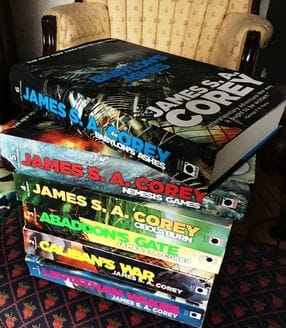 You must read James S. A. Corey’s Babylon’s Ashes, the sixth book in the epic series, The Expanse. Actually, no, you must first read the first five books, and then read Babylon’s Ashes. You must do this, because of its utterly perfect narration. (Spoiler Alert: Just a teensy one. It doesn't ruin the story, but if you want to know nothing of Babylon's Ashes before reading, don't read the last paragraph.) There are many reasons why these books are worth a read, and even a reread: the setting of a near-future solar system colonized by humans, the breakneck and detailed plot, and the delightful characters, to name a few. But it’s important to note that the voices of the characters are clear and well defined because of the narration. Narrative style is critical to why The Expanse books engage so well and read so beautifully. The narrative style of The Expanse is crisp limited omniscience; we transfer between different narrators with different perspectives. Sometimes the narrators overlap in one scene, but generally not; we see some scenes from the perspective of one character, and some scenes from the other. The narration is tailored to the voice of the character who is speaking, even in so far as the metaphors that they use to describe their world, or the parts of life that they muse on. We are left in no doubt that there is a new person speaking. The narrating characters change from one book to the next. Sometimes they are foul-mouthed grandmother politicians, sometimes scientists and preachers, sometimes female Martian marines wearing power armour. Sometimes they are the villain, the antagonist speaking in their own voice. And running through all the books is the idealistic and charming narration of James Holden, captain of the Rocinante. (If you’re a Firefly fan and are missing Malcolm Reynolds, James Holden is a pretty amazing substitute.) Babylon’s Ashes, the latest installment, takes this narrative control to new extremes. Most of the books consist of four narrators – Babylon’s Ashes has about triple that. It should be a dizzying collections of perspectives, but it manages to not be because so many of them are old friends; we’ve met them before on previous missions, in previous adventures, and their narration manages to glide easily through the vast scope of this story. The storytelling of Babylon’s Ashes is most impressive when we hear the brief voices of those we have never met before. They seem inconsequential; they are bystanders, observers of mass conflict, a perspective that is neither the protagonist nor the antagonist. They are, of course, not inconsequential – they are exactly the point. Conflict on the scale of Babylon’s Ashes cannot be confined to the hero and the villain only; it ripples through their worlds and takes all human lives with it. There is a moment in Babylon’s Ashes when one character starts making videos of the lives of other people. He broadcasts them throughout the solar system, in an attempt to find some humanity and understanding in the midst of conflict. His action inspires others to make their own videos, to speak in their own voices. That is what the narration of Babylon’s Ashes is: the voices of humanity, in all their variety, telling one story.
1 Comment
Booty
1/14/2017 10:07:08 am
Love your style with kids, your subtle cajoling, getting them to want more, even before they get into your classroom -- like it's their right... and believe me it is! All good teachers find ways to take their students on journeys right there in the classroom. It happens via a myriad of strategies, often starting as experiments that the experimenter knows might fail, but the indicators of success are always evident, like when an incoming student insists on knowing if he/she can expect the same experiences.
Reply
Leave a Reply. |
Author
Jane Perrella. Teacher, writer. Expert knitter. Enthusiast of medieval swordplay, tea, Shakespeare, and Batman. Archives
June 2019
Categories |
 RSS Feed
RSS Feed
